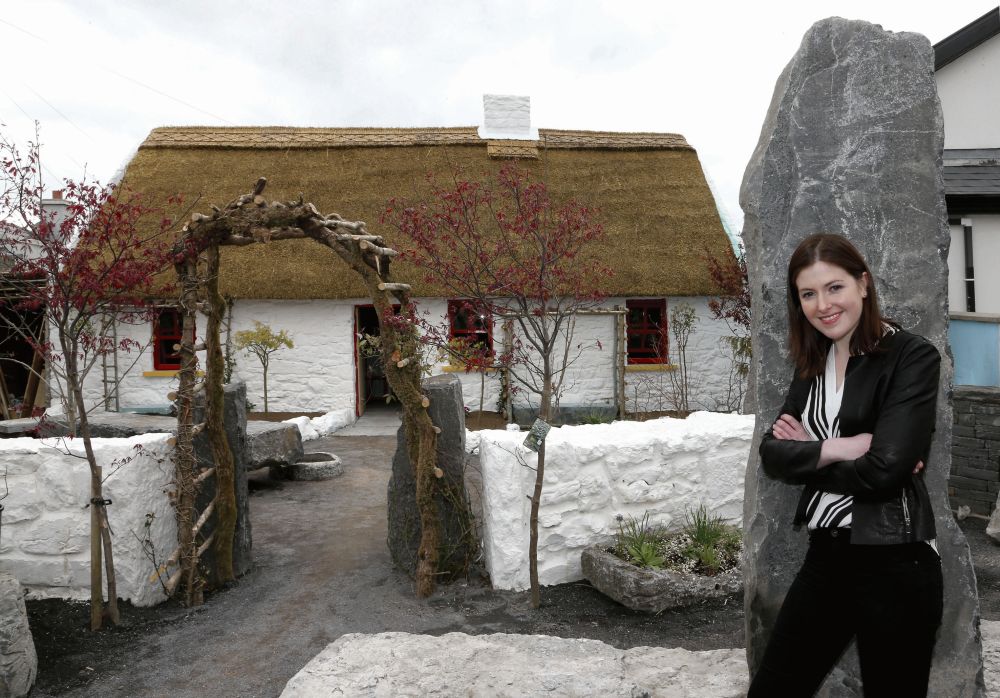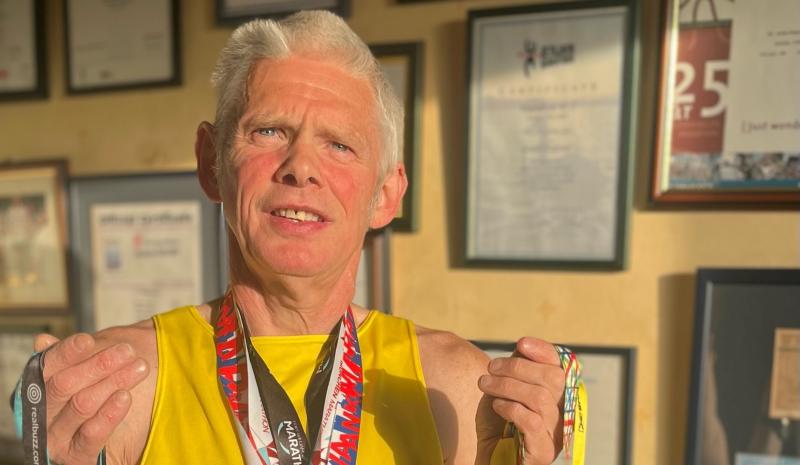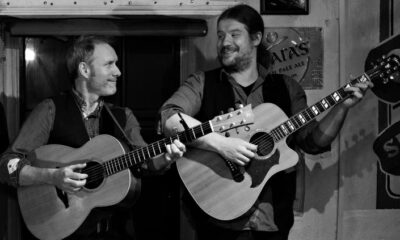News
Claddagh ‘housheen’ is a step back into history

For the first time in over 80 years, an authentic Claddagh cottage is to open its half-doors to the people of Galway in one of the oldest villages in the land.
The cottage has been been a labour of love for the family behind the Claddagh Arts Centre who hope to attract locals and visitors alike to take a step back into a world long gone.
The walls have been built with lime mortar and local stone, some sourced from an original thatched Claddagh cottage and then whitewashed in the traditional picturesque way.
A stone fireplace has been added made of locally-sourced stone and the roof was constructed from bog oak rafters, cross members of hazel and willow before being topped with bog scraw and finished in wheaten straw thatch. The floor boasts indigenous flagstone, windows of old-style timber sash with front and backdoor half-doors.
The cottage on Upper Fairhill Road promises to be a hive of activity with workshops on stone and wood carving planned, with the space available for community events such as traditional music nights, Irish language classes and charity fundraisers.
The cottage dovetails into the arts centre where there are traditional bog oak sculptures as well as wood and stone carvings for sale. Two stonemasons and two thatchers were employed to lend their skills to the cottage, but much of the work was done by volunteers recruited from the family.
Cathriona Walsh of the Claddagh Arts Centre has described the idyllic ‘housheen’ as “the only authentic Claddagh cottage in the world”. They have funded the project without any grants or public donations despite a plea on a crowd funding website.
“We applied for so many grants, but nothing ever materialised. They said it was a private enterprise but it’s going to be a museum with the tea brewing and the scones baking over the fire. A place to come for a chat and to relax in our beautiful landscaped gardens,” she explained.
“We haven’t got a final costing but it’s cost at least €50 to €60,000. I and my parents have put the money into it. It’s the final push now, but it’s difficult as I’m going into pensions,” said the 25-year-old accountant.
“The cottage will be a tourist attraction, a huge addition to Galway’s cultural attributes, a museum and a place where descendants from the old Claddagh people can come to learn about their history.”
Already it has proved a magnet for tourists walking around the Claddagh, wondering how something so new could appear so old.
Kay Conroy, who had tried to fundraise to rebuild a Claddagh cottage as far back as 1968 but was unable to get a suitable site, was given the honour of turning the first sod on the build last October.
The Claddagh Arts Centre opened three years ago and has become an unlikely haven for local crafts. The family hope the draw of the thatched cottage will attract even more visitors.
The Claddagh is one of the oldest villages in Ireland with its existence having first been recorded with the arrival of Christianity in the 5th century. Claddagh locals supplied the city with seafood up until the 19th century and hosted regular fish markets.
The original cottages were demolished in 1935 to make way for a local authority estate. With the help of books, photos and the knowledge of locals, the family have gone to a lot of effort to ensure the cottage’s authenticity in dimensions, materials, layout and contents.
Initially the plans were given the thumbs down by planners, who complained about unauthorised uses on the site, including the sale of firewood and turf and physiotherapy services. They also found that elements of the original design did not accord with a traditional cottage and requested the Centre to liaise with the Council’s Heritage Officer to address concerns over the accuracy of certain elements.
Connacht Tribune
West has lower cancer survival rates than rest

Significant state investment is required to address ‘shocking’ inequalities that leave cancer patients in the West at greater risk of succumbing to the disease.
A meeting of Regional Health Forum West heard that survival rates for breast, lung and colorectal cancers than the national average, and with the most deprived quintile of the population, the West’s residents faced poorer outcomes from a cancer diagnosis.
For breast cancer patients, the five-year survival rate was 80% in the West versus 85% nationally; for lung cancer patients it was 16.7% in the west against a 19.5% national survival rate; and in the West’s colorectal cancer patients, there was a 62.6% survival rate where the national average was 63.1%.
These startling statistics were provided in answer to a question from Ballinasloe-based Cllr Evelyn Parsons (Ind) who said it was yet another reminder that cancer treatment infrastructure in the West was in dire need of improvement.
“The situation is pretty stark. In the Western Regional Health Forum area, we have the highest incidence of deprivation and the highest health inequalities because of that – we have the highest incidences of cancer nationally because of that,” said Cllr Parsons, who is also a general practitioner.
In details provided by CEO of Saolta Health Care Group, which operates Galway’s hospitals, it was stated that a number of factors were impacting on patient outcomes.
Get the full story in this week’s Connacht Tribune, on sale in shops now, or you can download the digital edition from www.connachttribune.ie. You can also download our Connacht Tribune App from Apple’s App Store or get the Android Version from Google Play.
Connacht Tribune
Marathon Man plans to call a halt – but not before he hits 160 races

On the eve of completing his 150th marathon, an odyssey that has taken him across 53 countries, Loughrea’s Marathon Man has announced that he is planning to hang up his running shoes.
But not before Jarlath Fitzgerald completes another ten races, making it 160 marathons on the occasion of his 60th birthday.
“I want to draw the line in 2026. I turn 57 in October and when I reach 60 it’s the finishing line. The longer races are taking it out of me. I did 20 miles there two weeks ago and didn’t feel good. It’s getting harder,” he reveals.
“I’ve arthritis in both hips and there’s wear and tear in the knees.”
We speak as he is about to head out for a run before his shift in Supervalu Loughrea. Despite his physical complaints, he still clocks up 30 miles every second week and generally runs four days a week.
Jarlath receives injections to his left hip to keep the pain at bay while running on the road.
To give his joints a break, during the winter he runs cross country and often does a five-mile trek around Kylebrack Wood.
He is planning on running his 150th marathon in Cork on June 4, where a group of 20 made up of work colleagues, friends and running mates from Loughrea Athletics Club will join him.
Some are doing the 10k, others are doing the half marathon, but all will be there on the finishing line to cheer him on in the phenomenal achievement.
Get the full story in this week’s Connacht Tribune, on sale in shops now, or you can download the digital edition from www.connachttribune.ie. You can also download our Connacht Tribune App from Apple’s App Store or get the Android Version from Google Play.
CITY TRIBUNE
Galway ‘masterplan’ needed to tackle housing and transport crises

From the Galway City Tribune – An impassioned plea for a ‘masterplan’ that would guide Galway City into the future has been made in the Dáil. Galway West TD Catherine Connolly stated this week that there needed to be an all-inclusive approach with “vision and leadership” in order to build a sustainable city.
Deputy Connolly spoke at length at the crisis surrounding traffic and housing in Galway city and said that not all of the blame could be laid at the door of the local authority.
She said that her preference would be the provision of light rail as the main form of public transport, but that this would have to be driven by the government.
“I sat on the local council for 17 years and despaired at all of the solutions going down one road, metaphorically and literally. In 2005 we put Park & Ride into the development plan, but that has not been rolled out. A 2016 transport strategy was outdated at the time and still has not been updated.
“Due to the housing crisis in the city, a task force was set up in 2019. Not a single report or analysis has been published on the cause of the crisis,” added Deputy Connolly.
She then referred to a report from the Land Development Agency (LDA) that identified lands suitable for the provision of housing. But she said that two-thirds of these had significant problems and a large portion was in Merlin Park University Hospital which, she said, would never have housing built on it.
In response, Minister Simon Harris spoke of the continuing job investment in the city and also in higher education, which is his portfolio.
But turning his attention to traffic congestion, he accepted that there were “real issues” when it came to transport, mobility and accessibility around Galway.
“We share the view that we need a Park & Ride facility and I understand there are also Bus Connects plans.
“I also suggest that the City Council reflect on her comments. I am proud to be in a Government that is providing unparalleled levels of investment to local authorities and unparalleled opportunities for local authorities to draw down,” he said.
Then Minister Harris referred to the controversial Galway City Outer Ring Road which he said was “struck down by An Bord Pleanála”, despite a lot of energy having been put into that project.
However, Deputy Connolly picked up on this and pointed out that An Bord Pleanála did not say ‘No’ to the ring road.
“The High Court said ‘No’ to the ring road because An Bord Pleanála acknowledged it failed utterly to consider climate change and our climate change obligations.
“That tells us something about An Bord Pleanála and the management that submitted such a plan.”
In the end, Minister Harris agreed that there needed to be a masterplan for Galway City.
“I suggest it is for the local authority to come up with a vision and then work with the Government to try to fund and implement that.”


















